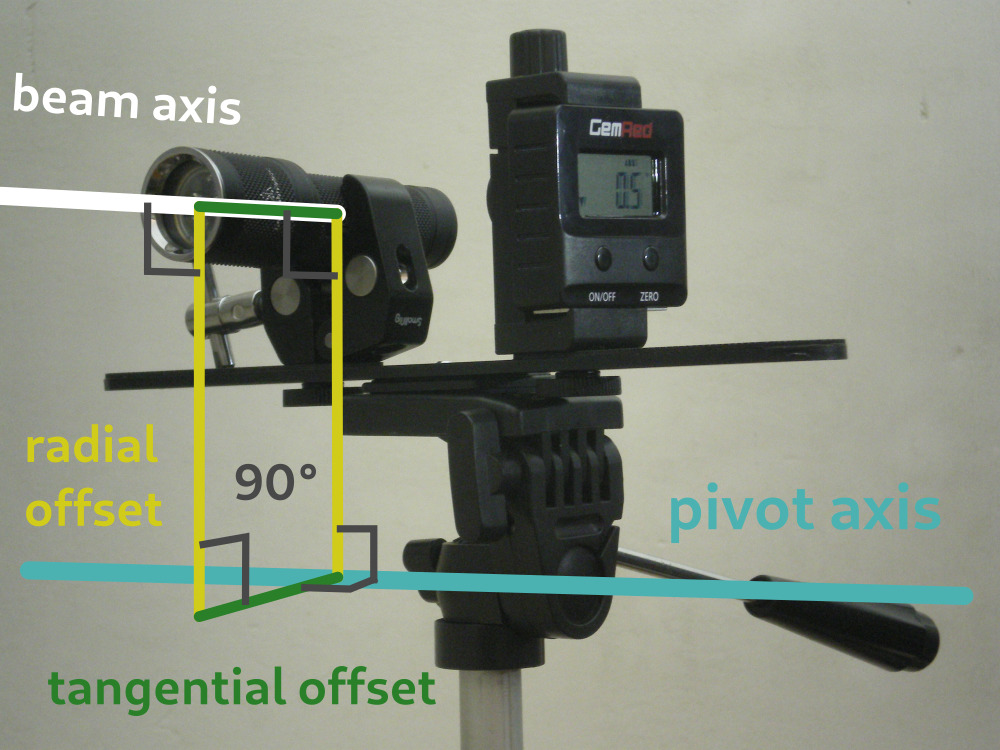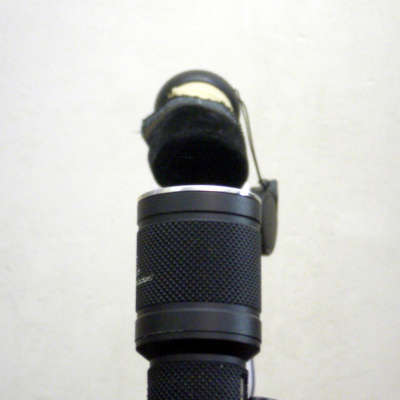Integrate your lumens mechanically
Back to the appThe Beam Profiler is a tool for measuring the output of lights. More formally it is known as a goniophotometer. Thank you to the contributors at Patreon for sponsoring the development of this hardware. Questions should be directed to my subreddit. Here is how this version compares to DIY integration spheres:
| Integration Sphere | Beam Profiler | |
|---|---|---|
| speed | instant | minutes |
| measures | lumens | lumens, candela, shape |
| works with | any light small enough to fit | radially symmetric beams |
| bulk | large | compact |
| construction | difficult | easy |
| calibration | required | optional |
| extra steps | a multiplication | a webapp |
Operating
- Measure the dimensions of the testing rig.
- Put measurements into the webapp.
- Aim the light directly at the luxmeter.
- Zero the angle finder.
- Record lux at 0 degrees.
- Pivot the light upwards until the luxmeter reads 0 lux.
- Record degrees at 0 lux.
- Add more angle-lux pairs until the render looks like the white wall beamshot.
Parts List
This list is somewhat overkill. It is for the person who has nothing and wants to do as little DIY as possible. I encourage you to use whatever you have on hand.
A luxmeter. I recommend the WT81B luxmeter. It is the best hobbyist luxmeter on the market:
- $30
- bluetooth
- 0.1 lux resolution
- temperature compensation
- open source library
- internal memory
- tripod mount
It can be purchased at Walmart or Aliexpress. Occasionally it is available through Amazon: non-affiliate search and affiliate search.
A digital angle finder. The best value for money that I have found is the GemRed 82421. Non-affiliate link and affiliate link It is also possible to use a smartphone with a bubble-level app. But I have found those apps to be very unreliable past 80 degrees of tilt.
2 tripods though there is a lot of room for improvisation here. Tripods are certainly the easiest answer to mounting stuff. The rest of the mounting hardware suggestions assume you are using tripods.
A clamp to hold the light. This clamp can handle lights up to 50mm diameter and also works for angleheads. Non-affiliate link and affiliate link
A cell phone mount to hold the angle finder. Non-affiliate link and affiliate link
Both of these are secured to the tripod with a flash extension bar. Non-affiliate link and affiliate link
You'll also want a tape measure for finding the offsets and luxmeter distance. Though a laser distance meter is really convenient for getting the range to the luxmeter with millimeter accuracy. Non-affiliate link and affiliate link
Tips and Suggestions
Do not try to measure the maximum turbo mode of a light. The output must be flat and consistent for several minutes while collecting data. Its easy to scale up the measured lumens afterwards.
A luxmeter with 0.1 lux resolution like the WT81B or GM1020 or UT382 is highly recommended. Those fractions of a lux can matter when measuring the spill.
Make a collimating shroud for your luxmeter. Mine is pictured at right. Its a toilet paper tube and a scrap of black velvet fabric. With a shroud the luxmeter is completely blind to all indirect illumination. The meter is in a brightly lit setting but reading 0.0 lux. This allows you to take measurements without any worry about light leakage.
It is a lot easier to center and align the light when there is a white wall behind the luxmeter. Sight down along the light and it becomes obvious if alignment is less than perfect.
You should cycle through all the modes and get their lux readings immediately after initially centering the beam. Its more convenient than doing it later.
Make sure that the luxmeter can still see the flashlight at the extremes of rotation. Tilt the light back and confirm there is still a direct line of sight. In the 3rd picture the light can no longer "see" the sensor. There are several ways of correcting this:
- Move the light farther away.
- Tweak the mounts to have smaller offsets.
- Make the collimating shroud fatter.
- Make the collimating shroud shorter.
It is a good idea to have the luxmeter be several meters away from the light. This minimizes errors as the light is moved around.
If your luxmeter only has 1 lux resolution you might need to put it much closer to get reliable spill measurements. It is a good idea to check that the luxmeter can measure the dimmest portions of the spill before performing a set of measurements. However be aware the beam shape will mimic any artifacts in the beam at close range. The lumens will be the same regardless.
Don't worry about hitting exact angles. You don't need to take readings at exactly every 10.0° for the results to be good. There is a lot of math in the app to produce good results from what you can give it.
Take readings on either side of large changes in brightness. Don't try to get readings in the middle of an abrupt cliff. The app will smoothly connect the dots. So give it points from the top and bottom of the cliff instead.
Some dark colored fabric is useful for controlling reflections. Normally these aren't an issue because of the collimating shroud. But you might want to drape some fabric behind the flashlight if the beam is so wide that the luxmeter can see light coming from 180° that bounces off the walls behind the flashlight.
Copy down and save your measurements and test setup. As features are added to the webapp you might want to plug your old measurements back in. Use the "export" button to copy the table into the clipboard to then paste into a spreadsheet.
Consider taking a screenshot as a way of saving your measurements and making it easy to share the results.
Want to make your own graphs? Copy out the "true angle" and "candela" columns into a spreadsheet and graph those. These have all the trigonometric corrections applied.
Calibration isn't required if the luxmeter and tape measure are accurate. There is no need to perform a calibration yourself. It is easy to buy luxmeters with certificates of calibration.
Very large heavy lights will need a different setup. I am still working on this. But the general idea will be to use a horizontally mounted angle finder which is clamped down to a table. The table would bear the entire weight of the light so there is no upper weight limit as with tripod heads. It would require the use of a different style of angle finder and some creative mounting ideas.




